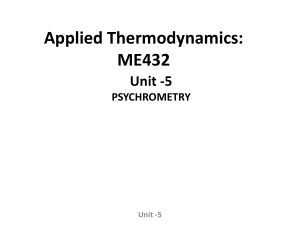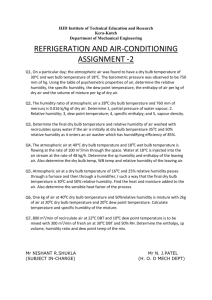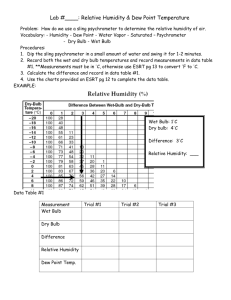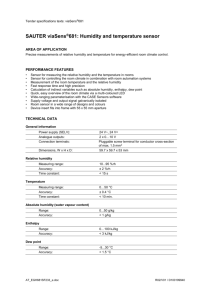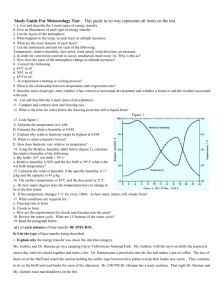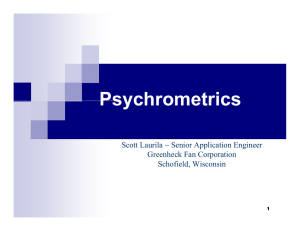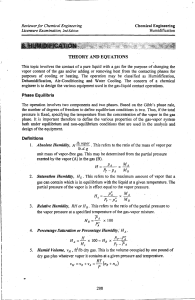4.42 F’10 Assignment #5
advertisement
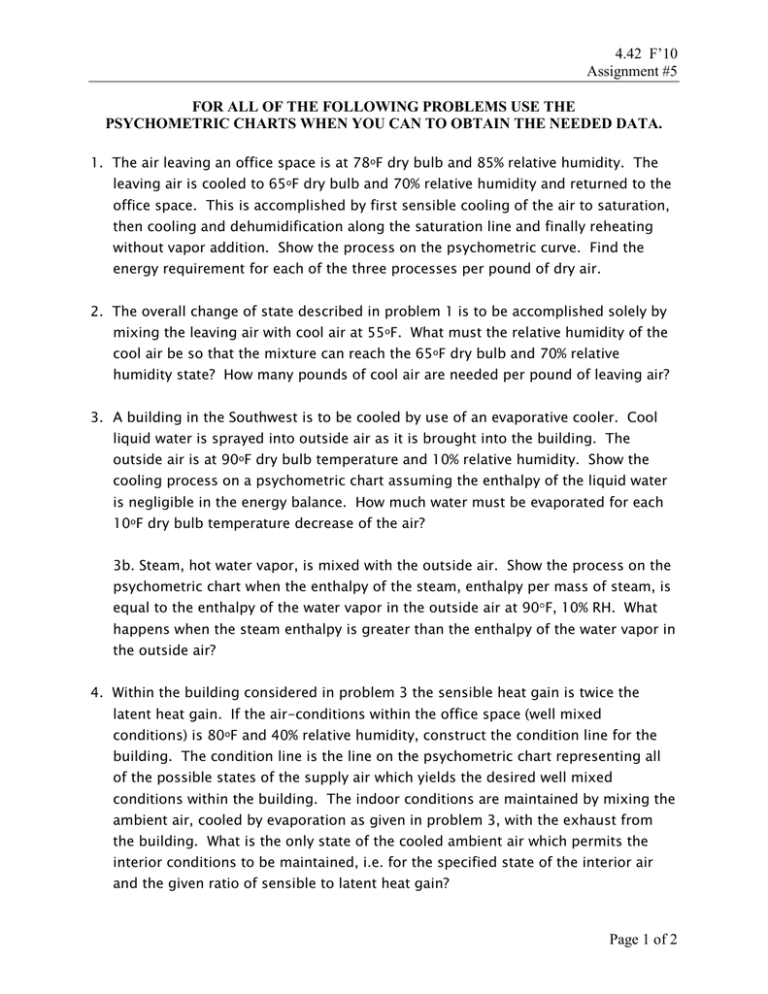
4.42 F’10 Assignment #5 FOR ALL OF THE FOLLOWING PROBLEMS USE THE PSYCHOMETRIC CHARTS WHEN YOU CAN TO OBTAIN THE NEEDED DATA. 1. The air leaving an office space is at 78oF dry bulb and 85% relative humidity. The leaving air is cooled to 65oF dry bulb and 70% relative humidity and returned to the office space. This is accomplished by first sensible cooling of the air to saturation, then cooling and dehumidification along the saturation line and finally reheating without vapor addition. Show the process on the psychometric curve. Find the energy requirement for each of the three processes per pound of dry air. 2. The overall change of state described in problem 1 is to be accomplished solely by mixing the leaving air with cool air at 55oF. What must the relative humidity of the cool air be so that the mixture can reach the 65oF dry bulb and 70% relative humidity state? How many pounds of cool air are needed per pound of leaving air? 3. A building in the Southwest is to be cooled by use of an evaporative cooler. Cool liquid water is sprayed into outside air as it is brought into the building. The outside air is at 90oF dry bulb temperature and 10% relative humidity. Show the cooling process on a psychometric chart assuming the enthalpy of the liquid water is negligible in the energy balance. How much water must be evaporated for each 10oF dry bulb temperature decrease of the air? 3b. Steam, hot water vapor, is mixed with the outside air. Show the process on the psychometric chart when the enthalpy of the steam, enthalpy per mass of steam, is equal to the enthalpy of the water vapor in the outside air at 90 F, 10% RH. What happens when the steam enthalpy is greater than the enthalpy of the water vapor in the outside air? 4. Within the building considered in problem 3 the sensible heat gain is twice the latent heat gain. If the air-conditions within the office space (well mixed conditions) is 80oF and 40% relative humidity, construct the condition line for the building. The condition line is the line on the psychometric chart representing all of the possible states of the supply air which yields the desired well mixed conditions within the building. The indoor conditions are maintained by mixing the ambient air, cooled by evaporation as given in problem 3, with the exhaust from the building. What is the only state of the cooled ambient air which permits the interior conditions to be maintained, i.e. for the specified state of the interior air and the given ratio of sensible to latent heat gain? Page 1 of 2 4.42 F’10 Assignment #5 5. A small portable dehumidifier is a single self-contained unit that is placed inside a room. It has one air inlet and one air outlet for the entire unit (the dehumidifier does not have any direct contact with the air outside the house). Air enters at 24 C dry bulb temperature and 80 percent relative humidity. The volume flow rate of air is 245 CFM, 6.9 m3/min. The unit removes 40 pints of liquid water per day, approximately 19 kg/day, from the air when operated constantly at steady state. It consumes 400 W of electricity. Assume that there is negligible heat transfer from the cabinet of the unit to the surrounding air. Take the air density as 1.16 kg/m3 a) What is the specific humidity in g/kg of the air leaving the unit? b) What is the dry bulb temperature of the air leaving the unit? Show the state of the inlet and leaving air on the psychometric chart. Air In 6.9 m3/min 24 C, 80% RH Portable Dehumidifier Air Out Specific humidity = ? T dry bulb = ? 400 W Liquid water 19 kg/day Page 2 of 2 MIT OpenCourseWare http://ocw.mit.edu 4.42J / 1.044J / 2.45J Fundamentals of Energy in Buildings Fall 2010 For information about citing these materials or our Terms of Use, visit: http://ocw.mit.edu/terms.
